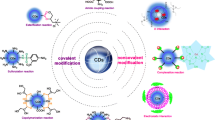Abstract
We present herein a facile strategy for fabrication of fluorescent-ultrahydrophobic bifunctional ligand-free CdS quantum dots (QDs) using cadmium acetate, sodium sulfide as starting materials, and ethanol as the solvent. The as-prepared CdS QDs without ligands exhibit good photochemical stability and photoluminescence (PL) in comparison with the previously reported aqueous CdS QDs. The effects of various experimental variables, including Cd/S molar ratio, reaction time, and reaction temperature on the optical properties of the obtained CdS QDs have been systematically investigated. Subsquently, dodecanethiol was introduced to modify these CdS QDs, further conferring them with superhydrophobic property, along with good compatibility with polymers. The features and structures of the as-prepared QDs and their hybrids on UV–Vis, PL spectroscopy, Fourier transform infrared, transmission electron microscope, X-ray diffraction, and contact angle have been disscussed.









Similar content being viewed by others
References
Salter CL, Stevenson RM, Farrer I, Nicoll CA, Ritchie DA, Shields AJ (2010) An entangled-light-emitting diode. Nature 465:594–597
Tessler N, Medvedev V, Kazes M, Kan SH, Banin U (2002) Efficient near-infrared polymer nanocrystal light-emitting diodes. Science 295:1506–1508
Mamedov AA, Belov A, Giersig M, Mamedova NN, Kotov NA (2001) Nanorainbows: graded semiconductor films from quantum dots. J Am Chem Soc 123:7738–7739
Fang Q, Yat L, Gradeak S, Park HG, DonYJ DY, Wang ZL, Lieber CM (2008) Multi-quantum-well nanowire heterostructures for wavelength-controlled lasers. Nat Mater 7:701–706
Allen PM, Liu W, Chauhan VP, Lee J, Ting AY, Fukumura D, Jain RK, Bawendi MG (2009) InAs (ZnCdS) quantum dots optimized for biological imaging in the near-infrared. J Am Chem Soc 132:470–471
Thakar R, Chen Y, Snee PT (2007) Efficient emission from core/(doped) shell nanoparticles: applications for chemical sensing. Nano Lett 7:3429–3432
Peng ZA, Peng XG (2001) Formation of high-quality CdTe, CdSe, and CdS nanocrystals using CdO as precursor. J Am Chem Soc 123:183–184
Wang GF, Peng Q, Li YD (2011) Lanthanide-doped nanocrystals: synthesis, optical-magnetic properties, and applications. Accounts Chem Res 44:322–332
Liu Y, Tan T, Wang B, Zhai R, Song X, Li E, Wang H, Yan H (2008) Fabrication of CdS films with superhydrophobicity by the microwave assisted chemical bath deposition. J Colloid Interface Sci 320:540–547
Didenko YT, Suslick KS (2005) Chemical aerosol flow synthesis of semiconductor nanoparticles. J Am Chem Soc 127:12196–12197
Liu YX, Wang DS, Peng Q, Chu D, Liu XW, Li YD (2011) Directly assembling ligand-Free ZnO nanocrystals into three-dimensional mesoporous structures by oriented attachment. Inorg Chem 50:5841–5847
Redel E, Walter M, Thomann R, Hussein L, Krüger M, Janiak C (2010) Stop-and-go, stepwise and “ligand-free” nucleation, nanocrystal growth and formation of Au-NPs in ionic liquids (ILs). Chem Commun 46:1159–1161
Mertens SFL, Vollmer C, Held A, Aguirre MH, Walter M, Janiak C, Wandlowski T (2011) “Ligand-free” cluster quantized charging in an ionic liquid. Angew Chem Int Ed 50:9735–9738
Colvin VL, Schlamp MC, Alivisatos AP (1994) Light-emitting diodes made from cadmium selenide nanocrystals and a semiconducting polymer. Nature 370:354–357
Cui DH, Xu J, Zhu T, Paradee G, Ashok S, Gerhold M (2006) Harvest of near infrared light in PbSe nanocrystal-polymer hybrid photovoltaic cells. Appl Phys Lett 88:183111–183113
Noone KM, Strein E, Anderson NC, Wu PT, Jenekhe SA, Ginger DS (2010) Broadband absorbing bulk heterojunction photovoltaics using low-bandgap solution-processed quantum dots. Nano Lett 10:2635–2638
Huynh WU, Dittmer JJ, Alivisatos AP (2002) Hybrid nanorod-polymer solar cells. Science 295:2425–2427
Gur I, Fromer NA, Chen CP, Kanaras AG, Alivisatos AP (2007) Hybrid solar cells with prescribed nanoscale morphologies based on hyperbranched semiconductor nanocrystals. Nano Lett 7:409–414
Yang SY, Wang CF, Chen L, Chen S (2010) Facile dicyandiamide-mediated fabrication of well-defined CuO hollow microspheres and their catalytic application. Mater Chem Phys 120:296–301
Alhassid Y (2000) The statistical theory of quantum dots. Rev Mod Phys 72:895–971
Zhang H, Wang LP, Xiong HM, Hu LH, Yang B, Li W (2003) Hydrothermal synthesis for high-quality CdTe nanocrystals. Adv Mater 15:1712–1715
Pan DC, Wang Q, Jiang SC, Ji XL, An LJ (2005) Synthesis of extremely small CdSe and highly luminescent CdSe/CdS core-shell nanocrystals via a novel two-phase thermal approach. Adv Mater 17:176–179
Premachandran R, Banerjee S, John VT, McPherson GL (1997) The enzymatic synthesis of thiol-containing polymers to prepare polymer-CdS nanocomposites. Chem Mater 9:1342–1347
Wang CW, Moffitt MG (2004) Surface-tunable photoluminescence from block copolymer-stabilized cadmium sulfide quantum dots. Langmuir 20:11784–11796
Chen S, Hu CH, Chen L, Xu NP (2007) Facile fabrication of superhydrophobic surface from micro/nanostructure metal alkanethiolate based films. Chem Commun 19:1919–1921
Broek BVD, Frederix F, Bonroy K, Jans H, Jans K, Borghs G, Maes G (2011) Shape-controlled synthesis of NIR absorbing branched gold nanoparticles and morphology stabilization with alkanethiols. Nanotechnology 22:15601–15609
Nieciecka D, Krysinski P (2011) Interactions of doxorubicin with self-assembled monolayer-modified electrodes: electrochemical, surface plasmon resonance (SPR), and gravimetric studies. Langmuir 27:1100–1107
Adhikari B, Banerjee A (2010) Facile synthesis of water-soluble fluorescent silver nanoclusters and Hg-II sensing. Chem Mater 22:4364–4371
Sun TL, Wang GJ, Feng L, Liu BY, Ma YM, Jiang L, Zhu DB (2004) Reversible switching between superhydrophilicity and superhydrophobicity. Angew Chem Int Ed 43:357–360
Wang S, Yang S, Yang C, Li Z, Wang J, Ge W (2000) Poly(N-vinylcarbazole) (PVK) photoconductivity enhancement induced by doping with CdS nanocrystals through chemical hybridization. J Phys Chem B 104:11853–11858
Acknowledgments
This work was supported by the National High Technology Research and Development Program of China (863 Program) (2012AA030313), National Natural Science Foundation of China-NSAF (10976012), the Natural Science Foundations for Jiangsu Higher Education Institutions of China (10KJB530006 and 11KJB530004), the Colleges and Universities in Jiangsu Province Plans to Graduate Research and Innovation (Grant CXZZ12_0449), and the Priority Academic Program Development of Jiangsu Higher Education Institutions (PAPD).
Author information
Authors and Affiliations
Corresponding author
Rights and permissions
About this article
Cite this article
Zhang, Q., Yang, J., Wang, CF. et al. Facile fabrication of fluorescent-superhydrophobic bifunctional ligand-free quantum dots. Colloid Polym Sci 291, 717–723 (2013). https://doi.org/10.1007/s00396-012-2781-0
Received:
Revised:
Accepted:
Published:
Issue Date:
DOI: https://doi.org/10.1007/s00396-012-2781-0




